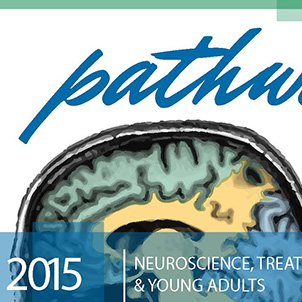
Graphic from the Pathways to Understanding Conference website.
One of the biggest holes in the net of services to treat teens with addictions lies not in what happens during residential treatment, but in what happens after youth leave a facility, a leading expert told a group at the Pathways to Understanding: Neuroscience, Treatment & Young Adults conference at Kennesaw State University Wednesday.
“Safe housing is the biggest need,” said Dr. Kevin McCauley, director of Program Services at New Roads Treatment Center in Sandy, Utah.
And by safe housing, he did not mean going back home to live with parents or other family members.
“That’s a terrible idea for everybody,” McCauley said. “There are triggers, old patterns, all kinds of things that interfere.”
McCauley was giving the keynote address at the conference, which continues until Friday. About 150 treatment professionals were assembled on the KSU campus to hear lectures from McCauley, whose keynote address was titled “The Brain and Recovery: An update on the neuroscience of addiction.” And while McCauley did go into detail about the effect of addiction on the frontal cortex, the anterior cingulate cortex and other parts of the brain, he said that meeting the needs of teens and young adults for housing was perhaps one of the most critical issues facing youth in recovery.
McCauley also talked about the role that epigenetics plays in addiction. Epigenetics, the emerging field that studies how certain genes may be expressed or suppressed because of environmental factors, can affect offspring of children two generations down the line. He cited a Swedish study in which scarcity affected whether the grandchildren of those who experienced scarcity were affected. He and Duke researcher Edward Levin, Ph.D., who followed McCauley, both cited studies that show that grandchildren of a woman who smokes can be affected. While they may not be more likely to become addicts, the research shows that many of them, women in particular, will have a harder time quitting.
McCauley questioned thinking that permits smokers in treatment to continue to smoke.
“This is a major, major problem,” he said. “The drug most likely to kill opioid addicts is nicotine.”
For years, treatment centers and those who treat addicts have believed that quitting all substances at once is too hard, McCauley said. Now, emerging science is revealing that nicotine addiction may fuel other addictions, he said. And, some studies have shown that an addict who continues to smoke for a year after he or she gains sobriety may never quit.
Levin from Duke said that quitting nicotine may be so hard because chronic smokers may have more nicotine receptors. He, too, worries about the lack of attention paid to helping addicts quit smoking, or worse, allowing them to take up smoking during treatment as a way to calm nerves or serve as a replacement.
And while much attention in recent years has focused on addiction as a brain disease, Levin reminded the group that addiction “is a brain disease and a behavioral disease.”
“It’s not just genes or my environment or even big tobacco,” said Levin.

This is a great initiative. If it helps, it is interesting to learn about the root cause of addiction. http://www.spiritualresearchfoundation.org/spiritual-problems/addictions/spiritual-causes-of-addiction/